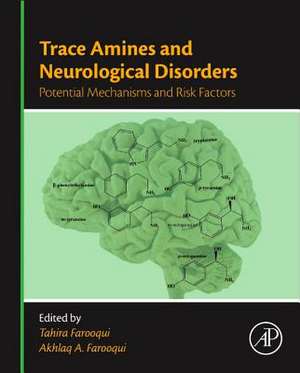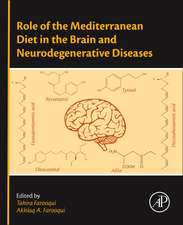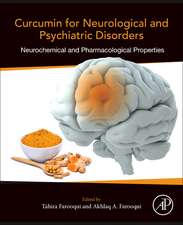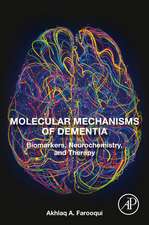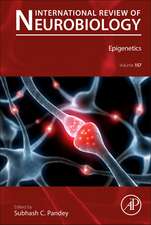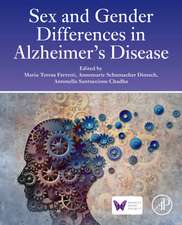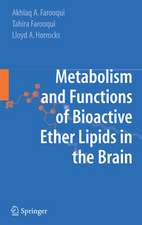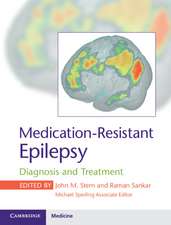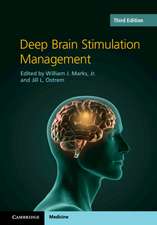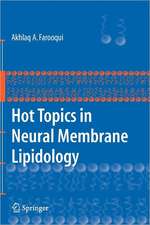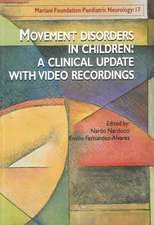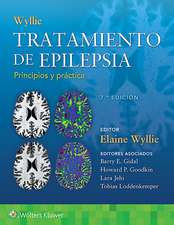Trace Amines and Neurological Disorders: Potential Mechanisms and Risk Factors
Editat de Tahira Farooqui, Akhlaq A. Farooquien Limba Engleză Hardback – 10 aug 2016
- Focuses on recent findings on trace amines, providing insights into the functional significance, molecular mechanisms, and biological relevance of TAARS in neurological disorders
- Edited work with chapters authored by leaders in the field from around the globe, the broadest, most expert coverage available
- Provides cutting-edge research on trace amines-mediated signaling in vertebrate model systems
Preț: 646.05 lei
Preț vechi: 801.87 lei
-19% Nou
Puncte Express: 969
Preț estimativ în valută:
123.62€ • 129.08$ • 102.08£
123.62€ • 129.08$ • 102.08£
Carte tipărită la comandă
Livrare economică 08-22 aprilie
Preluare comenzi: 021 569.72.76
Specificații
ISBN-13: 9780128036037
ISBN-10: 0128036036
Pagini: 432
Dimensiuni: 191 x 235 x 28 mm
Greutate: 1.07 kg
Editura: ELSEVIER SCIENCE
ISBN-10: 0128036036
Pagini: 432
Dimensiuni: 191 x 235 x 28 mm
Greutate: 1.07 kg
Editura: ELSEVIER SCIENCE
Public țintă
Practitioners and researchers in the fields of neuroscience, neurology, neuropharmacology, and neurochemistryCuprins
Section I. Introduction and Description of Trace Amines and Trace Amine-Associated Receptors
1. Trace Amines: An Overview
2. Methods of Trace Amines Analysis in Mammalian Brain
3. Synthesis and Neurochemistry of Trace Amines
4. The Origin and Evolution of the Trace Amine-Associated Receptor Family in Vertebrates
5. Differential Modulation of Adrenergic Receptor Signaling by Octopamine, Tyramine, Phenylethylamine, and 3-Iodothyronamine
6. Effects of Trace Amines on the Dopaminergic Mesencephalic System
7. Trace Amine-Associated Receptors in the Cellular Immune System
8. Trace Amines and Their Receptors in the Control of Cellular Homeostasis
9. Trace Amine-Associated Receptor 1 Modulation of Dopamine System
10. Trace Amines as Intrinsic Monoaminergic Modulators of Spinal Cord Functional Systems
11. Trace Amine-Associated Receptors: Ligands and Putative Role in the Central Nervous System
12. B-Phenylethylamine Requires the Dopamine Transporter to Release Dopamine in Caenorhabditis elegans
Section II. Trace Amines and Olfaction
13. Trace Amines-Mediated Olfactory Learning and Memory in Mammals and Insects: A Brief Comparative Review
14. Octopaminergic and Tyraminergic Signaling in the Honeybee (Apis mellifera) Brain: Behavioral, Pharmacological, and Molecular Aspects
15. Octopamine and Tyramine Signaling in Locusts: Relevance to Olfactory Decision-Making
Section III. Trace Amines and Neurological Disorders
16. Neurochemical Aspects of Neurological Disorders
17. Trace Amines and Their Relevance to Neurological Disorders: A Commentary
18. Trace Amines in Neuropsychiatric Disorders
19. B-Phenylethylamine-Class Trace Amines in Neuropsychiatric Disorders: A Brief Historical Perspective
20. Involvement of So-Called D-Neuron (Trace Amine Neuron) in the Pathogenesis of Schizophrenia: D-Cell Hypothesis
21. 3-Iodothyronamine, a New Chapter in Thyroid Story: Implications in Learning Processes
22. Trace Amine Receptors and Mood Disorders
23. Trace Amine Associated Receptor 1: Implications for Treating Stimulant Drug Addiction
24. Trace Amines and Their Potential Role in Primary Headaches
Section IV. Perspective
25. Perspective and Directions for Future Research on Trace Amines and Neurological Disorders
1. Trace Amines: An Overview
2. Methods of Trace Amines Analysis in Mammalian Brain
3. Synthesis and Neurochemistry of Trace Amines
4. The Origin and Evolution of the Trace Amine-Associated Receptor Family in Vertebrates
5. Differential Modulation of Adrenergic Receptor Signaling by Octopamine, Tyramine, Phenylethylamine, and 3-Iodothyronamine
6. Effects of Trace Amines on the Dopaminergic Mesencephalic System
7. Trace Amine-Associated Receptors in the Cellular Immune System
8. Trace Amines and Their Receptors in the Control of Cellular Homeostasis
9. Trace Amine-Associated Receptor 1 Modulation of Dopamine System
10. Trace Amines as Intrinsic Monoaminergic Modulators of Spinal Cord Functional Systems
11. Trace Amine-Associated Receptors: Ligands and Putative Role in the Central Nervous System
12. B-Phenylethylamine Requires the Dopamine Transporter to Release Dopamine in Caenorhabditis elegans
Section II. Trace Amines and Olfaction
13. Trace Amines-Mediated Olfactory Learning and Memory in Mammals and Insects: A Brief Comparative Review
14. Octopaminergic and Tyraminergic Signaling in the Honeybee (Apis mellifera) Brain: Behavioral, Pharmacological, and Molecular Aspects
15. Octopamine and Tyramine Signaling in Locusts: Relevance to Olfactory Decision-Making
Section III. Trace Amines and Neurological Disorders
16. Neurochemical Aspects of Neurological Disorders
17. Trace Amines and Their Relevance to Neurological Disorders: A Commentary
18. Trace Amines in Neuropsychiatric Disorders
19. B-Phenylethylamine-Class Trace Amines in Neuropsychiatric Disorders: A Brief Historical Perspective
20. Involvement of So-Called D-Neuron (Trace Amine Neuron) in the Pathogenesis of Schizophrenia: D-Cell Hypothesis
21. 3-Iodothyronamine, a New Chapter in Thyroid Story: Implications in Learning Processes
22. Trace Amine Receptors and Mood Disorders
23. Trace Amine Associated Receptor 1: Implications for Treating Stimulant Drug Addiction
24. Trace Amines and Their Potential Role in Primary Headaches
Section IV. Perspective
25. Perspective and Directions for Future Research on Trace Amines and Neurological Disorders
